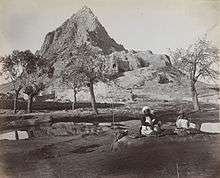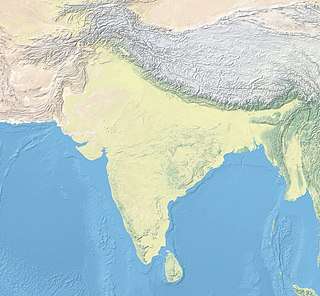Kandahar Bilingual Rock Inscription
| Kandahar Bilingual Rock Inscription/ (Kandahar Edict of Ashoka) | |
|---|---|
 | |
| Material | Rock |
| Size | H55xW49.5cm[1] |
| Writing | Greek and Aramaic |
| Created | circa 260 BCE |
| Period/culture | 3rd Century BCE |
| Discovered | 31°36′56.3N 65°39′50.5E |
| Place | Chehel Zina, Kandahar, Afghanistan |
| Present location | Kabul Museum, Afghanistan |
The Kandahar Bilingual Rock Inscription, (also Kandahar Edict of Ashoka, sometimes "Chehel Zina Edict"), is a famous bilingual edict in Greek and Aramaic, proclaimed and carved in stone by the Indian Maurya Empire ruler Ashoka (r.269-233 BCE) around 260 BCE. It is the very first known inscription of Ashoka, written in year 10 of his reign (260 BCE), preceding all other inscriptions, including his early Minor Rock Edicts, his Barabar caves inscriptions or his Major Rock Edicts.[2] This first inscription was written in Classical Greek and Aramaic exclusively. It was discovered in 1958.[1]
It is sometimes considered as one of the several "Minor Rock Edicts" of Ashoka (and then called "Minor Rock Edict No.4),[3] by opposition to his "Major Rock Edicts" which contain portions or the totality of his Edicts from 1 to 14.[4] Two edicts in Afghanistan have been found with Greek inscriptions, one of these being this bilingual edict in Greek language and Aramaic, the other being the Kandahar Greek Inscription in Greek only. This bilingual edict was found on a rock[5] on the mountainside of Chehel Zina (also Chilzina, or Chil Zena, "Forty Steps"),[1] in the vicinity of Kandahar, which forms the western natural bastion of Old Kandahar, or Alexandria Arachosia, Kandahar’s Old City.
The Edict is still in place on the mountainside. According to Scerrato, "the block lies at the eastern base of the little saddle between the two craggy hills below the peak on which the celebrated Cehel Zina of Babur are cut".[6] A cast is visible in Kabul Museum.[7] In the Edict, Ashoka advocates the adoption of "Piety" (using the Greek term Eusebeia for Dharma) to the Greek community.[8]
Background
Greek communities lived in the northwest of the Mauryan empire, currently in Pakistan, notably ancient Gandhara near the current Pakistani capital of Islamabad, and in the region of Gedrosia, nowadays in Southern Afghanistan, following the conquest and the colonization efforts of Alexander the Great around 323 BCE. These communities therefore seem to have been still significant in the area of Afghanistan during the reign of Ashoka, about 70 years after Alexander.[1]
Content
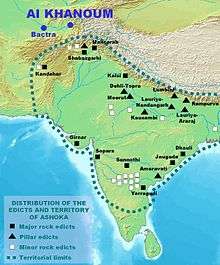
Ashoka proclaims his faith, 10 years after the violent beginning of his reign, and affirms that living beings, human or animal, cannot be killed in his realm. In the Hellenistic part of the Edict, he translates the Dharma he advocates by "Piety" εὐσέβεια, Eusebeia, in Greek. The usage of Aramaic reflect the fact that Aramaic (the so-called Official Aramaic) had been the official language of the Achaemenid Empire which had ruled in those parts until the conquests of Alexander the Great. The Aramaic is not purely Aramaic, but seems to incorporate some elements of Iranian.[9] According to D.D.Kosambi, the Aramaic is not an exact translation of the Greek, and it seems rather that both were translated separately from an original text in Magadhi, the common official language of India at the time, used on all the other Edicts of Ashoka in Indian language, even in such linguistically distinct areas as Kalinga.[8] It is written in Aramaic alphabet.
This inscription is actually rather short and general in content, compared to most Major Rock Edicts of Ashoka, including the other inscription in Greek of Ashoka in Kandahar, the Kandahar Greek Edict of Ashoka, which contains long portions of the 12th and 13th edicts, and probably contained much more since it was cut off at the beginning and at the end.
Implications
The proclamation of this Edict in Kandahar is usually taken as proof that Ashoka had control over that part of Afghanistan, presumably after Seleucos had ceded this territory to Chandragupta Maurya in their 305 BCE peace agreement.[10] The Edict also shows the presence of a sizable Greek population in the area, but it also shows the lingering importance of Aramaic, several decades after the fall of the Achaemenid Empire.[1][11] At the same epoch, the Greeks were firmly established in the newly created Greco-Bactrian kingdom under the reign of Diodotus I, and particularly in the border city of Ai-Khanoum, not far away in the northern part of Afghanistan.
According to Sircar, the usage of Greek in the Edict indeed means that the message was intended for the Greeks living in Kandahar, while the usage of Aramaic was intended for the Iranian populations of the Kambojas.[12]
Transcription
The Greek and Aramaic versions vary somewhat, and seem to be rather free interpretations of an original text in Prakrit. The Aramaic text clearly recognizes the authority of Ashoka with expressions such as "our Lord, king Priyadasin", "our lord, the king", suggesting that the readers were indeed the subjects of Ashoka, whereas the Greek version remains more neutral with the simple expression "King Ashoka".[13]

Greek (transliteration)
- δέκα ἐτῶν πληρη[ ... ]ων βασι[λ]εὺς
- Πιοδασσης εὐσέβεια[ν ἔδ]ε[ι]ξεν τοῖς ἀν-
- θρώποις, καὶ ἀπὸ τούτου εὐσεβεστέρους
- τοὺς ἀνθρώπους ἐποίησεν καὶ πάντα
- εὐθηνεῖ κατὰ πᾶσαν γῆν• καὶ ἀπέχεται
- βασιλεὺς τῶν ἐμψύχων καὶ οἱ λοιποὶ δὲ
- ἀνθρωποι καὶ ὅσοι θηρευταὶ ἤ αλιείς
- βασιλέως πέπαυνται θηρεύοντες καὶ
- εἲ τινες ἀκρατεῖς πέπαυνται τῆς ἀκρα-
- σίας κατὰ δύναμιν, καὶ ἐνήκοοι πατρὶ
- καὶ μητρὶ καὶ τῶν πρεσβυτέρων παρὰ
- τὰ πρότερον καὶ τοῦ λοιποῦ λῶιον
- καὶ ἄμεινον κατὰ πάντα ταῦτα
- ποιοῦντες διάξουσιν.
English (translation of the Greek)
- Ten years (of reign) having been completed, King
- Piodasses (Ashoka) made known (the doctrine of)
- Piety (εὐσέβεια, Eusebeia) to men; and from this moment he has made
- men more pious, and everything thrives throughout
- the whole world. And the king abstains from (killing)
- living beings, and other men and those who (are)
- huntsmen and fishermen of the king have desisted
- from hunting. And if some (were) intemperate, they
- have ceased from their intemperance as was in their
- power; and obedient to their father and mother and to
- the elders, in opposition to the past also in the future,
- by so acting on every occasion, they will live better
- and more happily."[14]
Aramaic (in Hebrew alphabet, stylized form of the Aramaic alphabet)
- שנן 10 פתיתו עביד זי מראן פרידארש מלכא קשיטא מהקשט
- מן אדין זעיר מרעא לכלהם אנשן וכלהם אדושיא הובד
- ובכל ארקא ראם שתי ואף זי זנה כמאכלא למראן מלכא זעיר
- קטלן זנה למחזה כלהם אנשן אתהחסינן אזי נוניא אחדן
- אלך אנשן פתיזבת כנם זי פרבסת הוין אלך אתהחסינן מן
- פרבסתי והופתיסתי לאמוהי ולאבוהי ולמזישתיא אנסן
- איך אסרהי חלקותא ולא איתי דינא לכלהם אנשיא חסין
- זנה הותיר לכלהם אנשן ואוסף יהותר.
English (translation of the Aramaic)
- Ten years having passed (?). It so happened (?) that our lord, king Priyadasin, became the institutor of Truth,
- Since then, evil diminished among all men and all misfortunes (?) lie caused to disappear; and [there is] peace as well as joy in the whole earth.
- And, moreover, [there is] this in regard to food: for our lord, the king, [only] a few [animals] are killed; having seen this, all men have given up [the slaughter of animals]; even (?) those men who catch fish (i.e. the fishermen) are subject to prohibition.
- Similarly, those who were without restraint have ceased to be without restraint.
- And obedience to mother and to father and to old men [reigns] in conformity with the obligations imposed by fate on each [person].
- And there is no Judgement for all the pious men,
- This [i.e. the practice of Law] has been profitable to all men and will be more profitable [in future].[15]
Other inscriptions in Greek in Kandahar
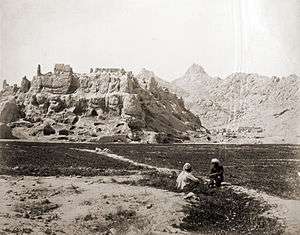
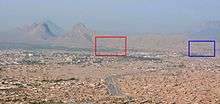
The other well-known Greek inscription, the Kandahar Greek Edict of Ashoka, was found 1.5 kilometers to the south of the Bilingual Rock Inscription, in the ancient city of Old Kandahar (known as Zor Shar in Pashto, or Shahr-i-Kona in Dari), Kandahar, in 1963.[10] It is thought that Old Kandahar was founded in the 4th century BCE by Alexander the Great, who gave it the Ancient Greek name Αλεξάνδρεια Aραχωσίας (Alexandria of Arachosia). The Edict is a Greek version of the end of the 12th Edicts (which describes moral precepts) and the beginning of the 13th Edict (which describes the King's remorse and conversion after the war in Kalinga). This inscription does not use another language in parallel.[16] It is a plaque of limestone, which probably had belonged to a building, and its size is 45x69.5 cm.[5][10] The beginning and the end of the fragment are lacking, which suggests the inscription was original significantly longer, and may have included all fourteen of Ashoka's Edicts, as in several other locations in India. The Greek language used in the inscription is of a very high level and displays philosophical refinement. It also displays an in-depth understanding of the political language of the Hellenic world in the 3rd century BCE. This suggest the presence of a highly cultured Greek presence in Kandahar at that time.[5]
Two other inscriptions in Greek are known at Kandahar. One is a dedication by a Greek man who names himself "son of Aristonax" (3rd century BCE). The other is an elegiac composition by Sophytos son of Naratos (2nd century BCE).[17]
 Kandahar Greek Edict of Ashoka, 3rd century BCE, Kandahar.
Kandahar Greek Edict of Ashoka, 3rd century BCE, Kandahar. Inscription in Greek by the "son of Aristonax", 3rd century BCE, Kandahar.
Inscription in Greek by the "son of Aristonax", 3rd century BCE, Kandahar.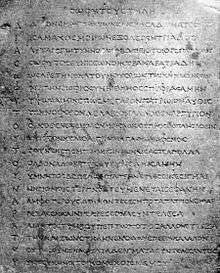 Kandahar Sophytos Inscription, 2nd century BCE, Kandahar.
Kandahar Sophytos Inscription, 2nd century BCE, Kandahar.
See also
- List of Edicts of Ashoka
- Edicts of Ashoka
- Greco-Buddhism
- The Greek-Aramaic inscription of Julius Aurelius Zenobius in the Great Colonnade at Palmyra.
References
- 1 2 3 4 5 6 7 Dupree, L. (2014). Afghanistan. Princeton University Press. p. 286. ISBN 9781400858910. Retrieved 2016-11-27.
- ↑ Valeri P. Yailenko Les maximes delphiques d'Aï Khanoum et la formation de la doctrine du dharma d'Asoka Dialogues d'histoire ancienne vol.16 n°1, 1990, pp.243
- ↑ Sircar, D. C. (1979). Asokan studies. p. 113.
- 1 2 For exact translation of the Aramaic see "Asoka and the decline of the Maurya" Romilla Thapar, Oxford University Presss, p.260
- 1 2 3 Une nouvelle inscription grecque d'Açoka, Schlumberger, Daniel, Comptes rendus des séances de l'Académie des Inscriptions et Belles-Lettres Année 1964 Volume 108 Numéro 1 pp. 126-140
- ↑ Scerrato, Umberto (1958). An inscription of Aśoka discovered in Afghanistan The bilingual Greek-Aramaic of Kandahar. p. 4.
- ↑ Kabul Museum
- 1 2 Notes on the Kandahar Edict of Asoka, D. D. Kosambi, Journal of the Economic and Social History of the Orient, Vol. 2, No. 2 (May, 1959), pp. 204-206
- ↑ History of Civilizations of Central Asia: The development of sedentary and nomadic civilizations: 700 B.C. to A.D. 250, Ahmad Hasan Dani Motilal Banarsidass Publ., 1999, p.398
- 1 2 3 Dupree, L. (2014). Afghanistan. Princeton University Press. p. 287. ISBN 9781400858910. Retrieved 2016-11-27.
- ↑ Indian Hist (Opt). McGraw-Hill Education (India) Pvt Limited. 2006. p. 1:183. ISBN 9780070635777. Retrieved 2016-11-27.
- ↑ Sircar, D. C. (1979). Asokan studies. p. 113.
- ↑ Sircar, D. C. (1979). Asokan studies. p. 113.
- ↑ Trans. by G.P. Carratelli "Archived copy". Archived from the original on 2012-02-01. Retrieved 2012-02-01. , see also here
- ↑ Sircar, D. C. (1979). Asokan studies. p. 115.
- ↑ Rome, the Greek World, and the East: Volume 1: The Roman Republic and the Augustan Revolution, Fergus Millar, Univ of North Carolina Press, 2003, p.45
- ↑ The Oxford Handbook of Ancient Greek Religion, Esther Eidinow, Julia Kindt, Oxford University Press, 2015,
Coordinates: 31°36′56.3″N 65°39′50.5″E / 31.615639°N 65.664028°E

